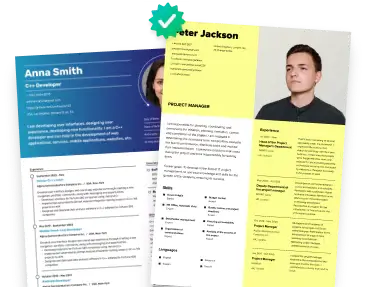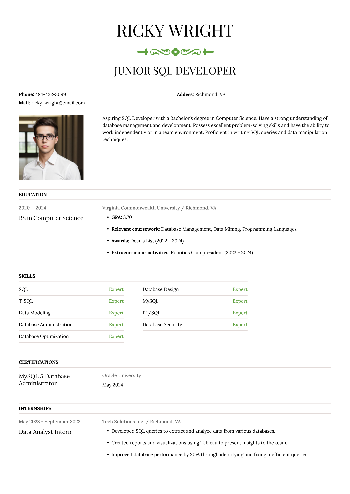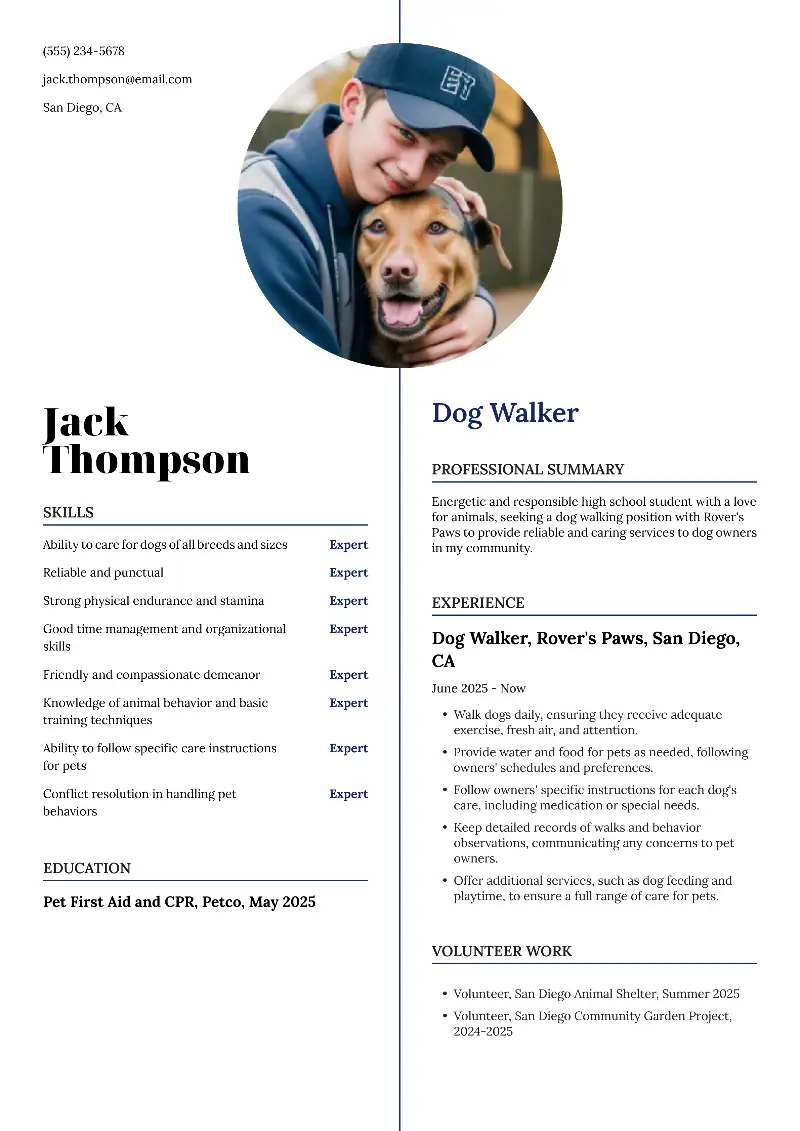When building robust and scalable web applications, mastering the right backend developer skills is essential.
These encompass a broad range of technical abilities and computer skills that ensure a seamless connection between the interface and the server-side logic. From database management to server configuration, these specialists plays a pivotal role in ensuring that applications run efficiently.
This article explores the key skills for a backend developer necessary to excel in this critical area.
Core backend developer skills
Create your professional Resume in 10 minutes for FREE
Build My Resume
Programming Languages
Backend developers use server-side languages to handle business logic, interact with databases, and create APIs. Key languages include Python, Java, Node.js, and Ruby, each suited to different types of applications.
- Learning Time: 2-6 months.
- Difficulty: Moderate
- How to learn: Follow tutorials and build simple applications or APIs. Practice coding regularly on platforms like LeetCode.
- Further Practice: Contribute to open-source projects on GitHub to deepen understanding and gain practical experience.
Databases
Databases store and manage application data. SQL databases (MySQL, PostgreSQL) are used for structured data, while NoSQL (MongoDB) is ideal for unstructured data.
- Learning Time: 2-4 months.
- Difficulty: Moderate, with SQL being easier to grasp initially than NoSQL models.
- How to learn: Start with basic SQL queries, then explore NoSQL databases. Build projects involving data storage and manipulation.
- Further Practice: Build complex database schemas and relationships. Practice SQL joins, indexing, and optimization techniques.
API Development
APIs allow communication between servers and clients. RESTful APIs are commonly used, while GraphQL offers more flexibility in data queries.
- Learning Time: 1-3 months.
- Difficulty: Moderate, especially when learning both design and integration practices.
- How to learn: Study the principles of REST and GraphQL by building APIs. Practice integrating them into web applications.
- Further Practice: Build authentication and rate-limiting mechanisms in APIs.
Authentication & Authorization
Authentication verifies user identity, while authorization controls access rights. Common methods include JWT, OAuth, and session-based authentication.
- Learning Time: 1-2 months.
- Difficulty: Moderate to high, due to security nuances and evolving standards.
- How to learn: Understand the basics through tutorials and build secure login systems. Practice implementing JWT or OAuth for token-based authentication.
- Further Practice: Integrate multi-factor authentication (MFA) and role-based access control (RBAC) into your applications.
Version Control
Git is used to track changes in code and enable collaboration among developers. Platforms like GitHub host repositories and manage versions.
- Learning Time: 1-2 months.
- Difficulty: Easy to moderate, depending on the complexity of collaboration workflows.
- How to learn: Discover Git basics (commits, branches, merges) via tutorials and practice by working on projects in a Git repository.
- Further Practice: Work on collaborative projects using GitFlow or other branching strategies.
Web Frameworks
Frameworks provide structures for building backend applications. Django (Python), Flask (Python), Express (Node.js), and Spring Boot (Java) streamline development.
- Learning Time: 2-4 months.
- Difficulty: Moderate, though it varies by framework and language familiarity.
- How to learn: Follow documentation and build small web apps. Learn how to handle routing, database connections, and authentication within a framework.
- Further Practice: Create CRUD apps, REST APIs, and integrate with frontend frameworks like React or Angular.
Containerization & Virtualization
Containers package applications and their dependencies, ensuring consistent environments. Kubernetes manages containers at scale for complex applications.
- Learning Time: 2-3 months for Docker, 3-6 months for Kubernetes.
- Difficulty: High for orchestration tools like Kubernetes, moderate for Docker.
- How to learn: Start by learning Docker basics and create containers for your apps. Explore Kubernetes for managing and scaling applications.
- Further Practice: Experiment with Docker in production environments and set up CI/CD pipelines that deploy Docker containers.
Cloud Computing
Cloud platforms provide infrastructure for deploying, hosting, and scaling applications. Popular providers include AWS, Google Cloud, and Azure.
- Learning Time: 3-6 months.
- Difficulty: Moderate to high, depending on the depth of platform knowledge needed.
- How to learn: Grasp cloud service basics (compute, storage, networking) through tutorials. Deploy apps and use cloud tools for project management.
- Further Practice: Deploy applications using serverless architectures (e.g., AWS Lambda, Google Cloud Functions).
Testing
Testing ensures code works as expected. Unit tests check individual functions, integration component interactions, and functional assess the entire system.
- Learning Time: 2-4 months.
- Difficulty: Moderate, with challenges around designing effective test cases.
- How to learn: Familiarize yourself with testing tools like PyTest, Mocha, or JUnit. Write tests for your code and integrate them into a CI/CD pipeline.
- Further Practice: Implement test-driven development (TDD) and practice mocking and stubbing.
Message Brokers & Queues
Message brokers handle asynchronous communication between services. They are crucial in event-driven architectures and microservices.
- Learning Time: 2-4 months.
- Difficulty: Moderate to high, especially when managing message reliability and scale.
- How to learn: Master the basics of message queues and build applications that use RabbitMQ or Kafka to process background tasks.
- Further Practice: Integrate message queues for background jobs, logging systems, or microservice communication.
Security Best Practices
Security protects applications and user data from unauthorized access. This includes encryption, securing APIs, and ensuring safe data transmission via HTTPS.
- Learning Time: Ongoing (basic understanding in 3 months).
- Difficulty: High, due to the constantly evolving threat landscape.
- How to learn: Study common vulnerabilities (e.g., SQL injection) and security best practices. Implement HTTPS and secure APIs in your projects.
- Further Practice: Implement encryption for sensitive data and HTTP headers like Content Security Policy (CSP) and HTTP Strict Transport Security (HSTS).
Microservices Architecture
Microservices break down applications into smaller, independent services that communicate over a network. This architecture is ideal for scalable, maintainable systems.
- Learning Time: 4-6 months.
- Difficulty: High, because of distributed system complexities and service coordination.
- How to learn: Understand architectural patterns, then build microservices using frameworks like Spring Boot or Node.js. Implement inter-service communication.
- Further Practice: Develop APIs that allow services to communicate via REST or messaging queues (e.g., RabbitMQ, Kafka).
Server Administration & Deployment (Nginx, Apache, CI/CD)
Server administration ensures web applications run smoothly. Tools like Nginx or Apache handle web traffic, while CI/CD pipelines automate deployment.
- Learning Time: 2-3 months.
- Difficulty: Moderate, increasing with infrastructure complexity and CI/CD depth.
- How to learn: Set up a web server and deploy applications on platforms like AWS or DigitalOcean. Learn CI/CD tools like Jenkins to automate deployment processes.
- Further Practice: Set up Nginx or Apache as reverse proxies for load balancing and SSL termination.
Resume examples with basic backend developer skills:
Advanced backend developer skills
Distributed Systems
Distributed systems enable applications to run across multiple servers or nodes. This architecture improves scalability, fault tolerance, and performance by spreading tasks across different machines.
- Learning Time: 4-6 months.
- How to learn: Study key concepts like consistency, partition tolerance, and high availability. Learn about CAP theorem, sharding, and load balancing.
- Further Practice: Build a distributed system with microservices and practice handling network failures, data synchronization, and fault tolerance.
Event-Driven Architecture
Event-driven architecture (EDA) enables components to communicate through events. This approach is widely used in systems that need to be highly scalable and responsive.
- Learning Time: 3-5 months.
- How to learn: Start by learning about events, message queues, and event producers/consumers. Build applications that react to real-time data streams.
- Further Practice: Implement event-based systems using tools like Apache Kafka or RabbitMQ. Explore event sourcing and CQRS patterns.
Graph Databases
Graph databases store as nodes, edges, and properties, making them ideal for representing complex relationships in data. Neo4j is a popular graph database.
- Learning Time: 2-4 months.
- How to learn: Explore the basics of graph theory and Cypher query language. Learn how to model relationships and queries in a graph format.
- Further Practice: Build applications that leverage graph data, such as social networks, recommendation engines, or fraud detection systems.
Serverless Architecture
Serverless computing abstracts away server management by letting developers deploy code that automatically scales. Platforms like AWS Lambda allow you to run backend functions without worrying about server provisioning.
- Learning Time: 2-4 months.
- How to learn: Study the basics of serverless platforms like AWS Lambda, Azure, and Google Cloud Functions. Start by building simple functions triggered by events.
- Further Practice: Explore creating complex serverless workflows, integrating with cloud databases, and using API Gateway to expose functions.
Message Queues & Stream Processing
Message queues and stream processing enable asynchronous communication between systems and the handling of real-time data streams. These technologies are key to building scalable and decoupled systems.
- Learning Time: 3-5 months.
- How to learn: Understand the basics of message queues, stream processing, and event-driven systems. Use tools like Apache Kafka or RabbitMQ to set up message brokers and producers/consumers.
- Further Practice: Build real-time applications such as chat systems, log aggregators, or analytics platforms. Learn about stream processing frameworks like Apache Flink or Spark.
Load Balancing & High Availability
Load balancing distributes incoming traffic across multiple servers to ensure high availability and fault tolerance. This is crucial for applications that need to handle a large number of users or requests.
- Learning Time: 2-4 months.
- How to learn: Master about different load balancing strategies (e.g., round-robin, least connections). Set up a load balancer with Nginx or HAProxy and experiment with scaling an application.
- Further Practice: Set up a fault-tolerant, high-availability architecture using auto-scaling groups and multi-region deployment in the cloud.
Continuous Integration / Deployment
CI/CD automates the testing, building, and deployment processes to ensure that code changes are smoothly integrated into production. It helps improve software delivery efficiency and reliability.
- Learning Time: 2-4 months.
- How to learn: Set up basic CI/CD pipelines using tools like Jenkins, CircleCI, or GitLab CI. Practice automating testing, build, and deployment workflows.
- Further Practice: Implement pipeline stages for security scans, code quality checks, and integration tests. Explore deployment strategies like blue-green or canary deployments.
Advanced Caching Strategies
Caching improves application performance by storing frequently accessed data in memory. Advanced caching strategies ensure that data is retrieved efficiently without overloading the database.
- Learning Time: 2-4 months.
- How to learn: Start by learning basic caching concepts and using Redis or Memcached to store and retrieve data. Learn about cache expiration, eviction policies, and consistency.
- Further Practice: Implement caching for APIs, session management, and database queries. Explore distributed caching strategies for scaling.
Resume samples with advanced backend developer skills:
Soft skills for a backend developer
While technical proficiency is essential, soft skills are just as critical to success in the workplace.
- What are soft skills?
- These refer to a set of personal attributes, traits, and interpersonal abilities that enable individuals to interact effectively and harmoniously with others.
Unlike hard skills, which are learned through training or education, these competencies are more related to communication, problem-solving, and emotional intelligence.
Soft backend developer skills examples:
- Logical thinking. The ability to break down problems into manageable parts and find efficient solutions is crucial.
- Communication. Backend developers need to effectively communicate with frontend ones, product managers, and other stakeholders to ensure the backend meets the required specifications.
- Teamwork. A strong ability to collaborate ensures smooth integration between the front and back ends.
- Prioritization. Balancing multiple tasks and prioritizing them based on urgency and importance is essential for delivering features on time.
- Willingness to learn. The tech landscape changes quickly, and backend developers need to stay up-to-date with new technologies, methodologies, and best practices.
- Attention to detail. Small mistakes in backend code can lead to bigger issues, such as security vulnerabilities or performance problems.
- Negotiation. When disagreements arise—whether it's about coding practices, feature design, or technical debt—you need to mediate and find common ground, ensuring progress isn't stalled.
FAQ
- How to become a backend developer?
- Start with programming languages like Python, Java, or Node.js. Learn about databases (SQL/NoSQL), web frameworks (Django, Express), and how to build and consume APIs. Get comfortable with Git for version control and practice by building small projects.
- What are the requirements for a backend developer?
- You need strong knowledge of server-side programming languages, database management, and APIs. Familiarity with version control (Git) and security basics is also important. Having problem-solving backend developer skills and the ability to work with cloud platforms like AWS or Azure is a plus for backend developer requirements.
- How should I organize programming languages on my resume?
- List them clearly under a "Skills" or "Technical Skills" section of your resume. Mention specific frameworks (e.g., Django, Spring, Express.js) you’ve worked with, and indicate your level of proficiency (e.g., "Intermediate", "Advanced").
Conclusion
Becoming a proficient specialist takes time, practice, and continuous learning and education.
Whether you're starting out or looking to enhance your backend developer skills, focusing on mastering programming languages, database management, cloud technologies, and system design will set you up for success.
As the technology landscape evolves, staying up to date with the latest tools and best practices will ensure you remain competitive in the ever-changing world.
Create your professional Resume in 10 minutes for FREE
Build My Resume









